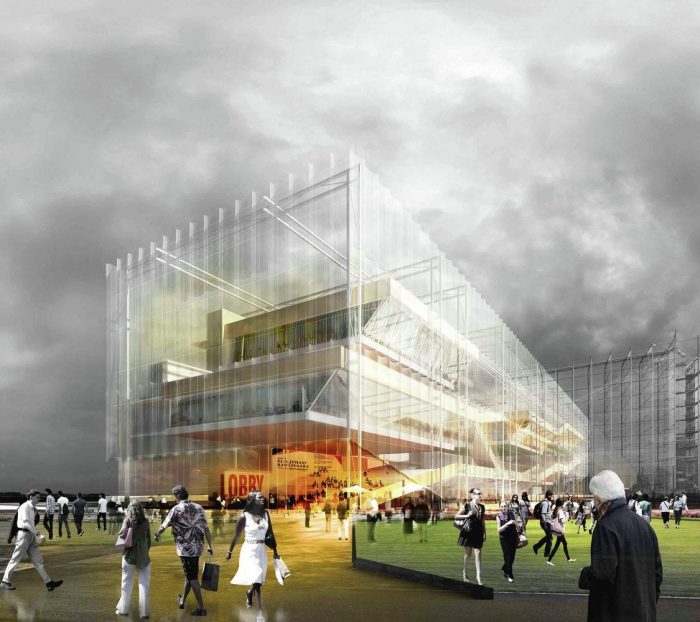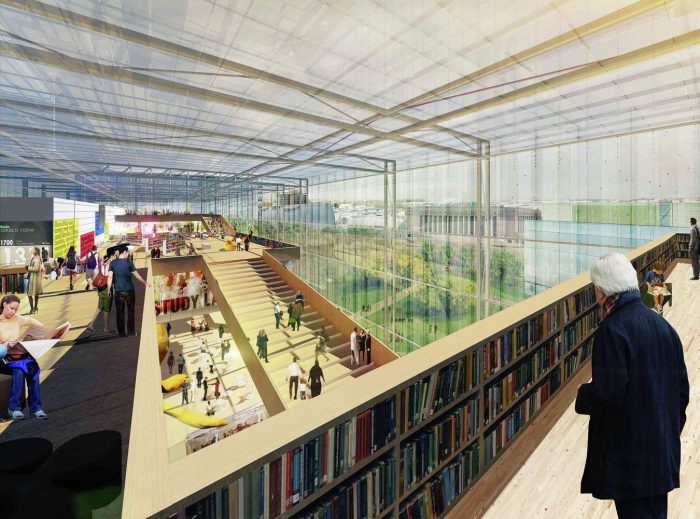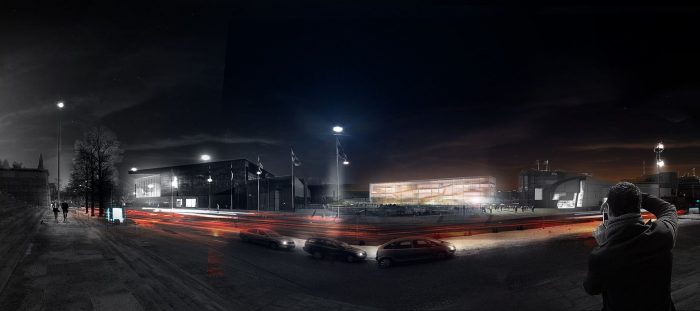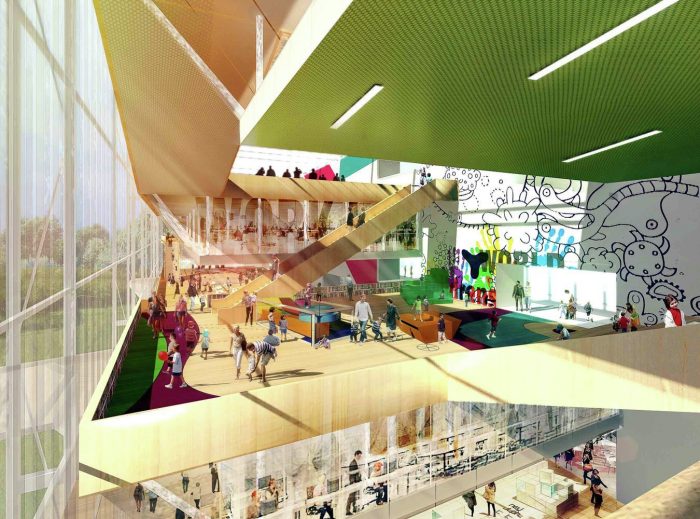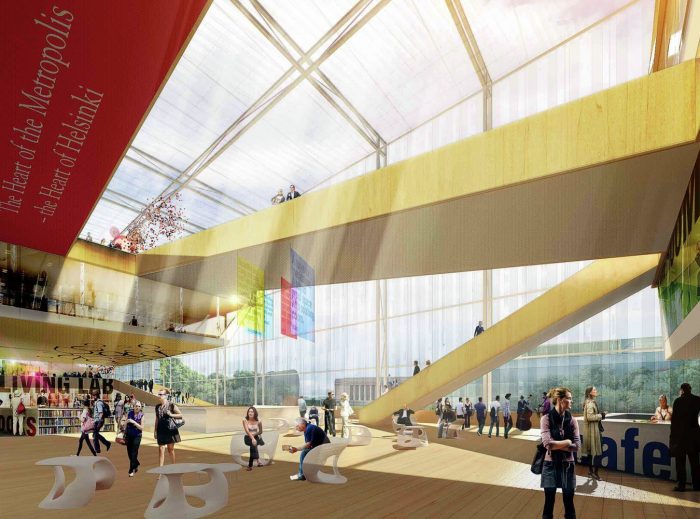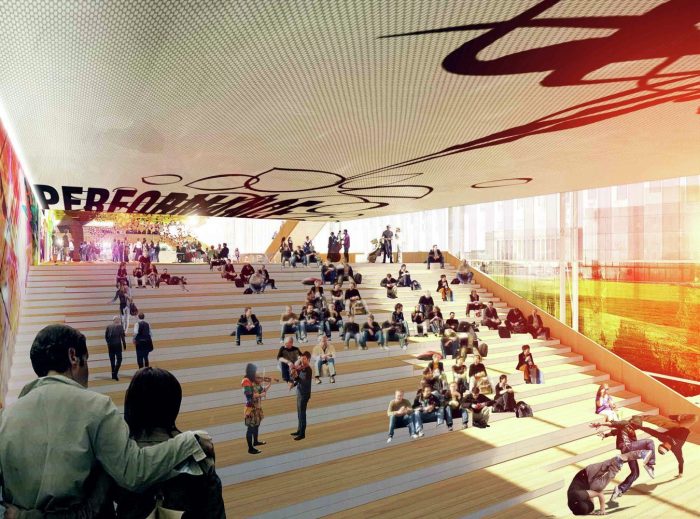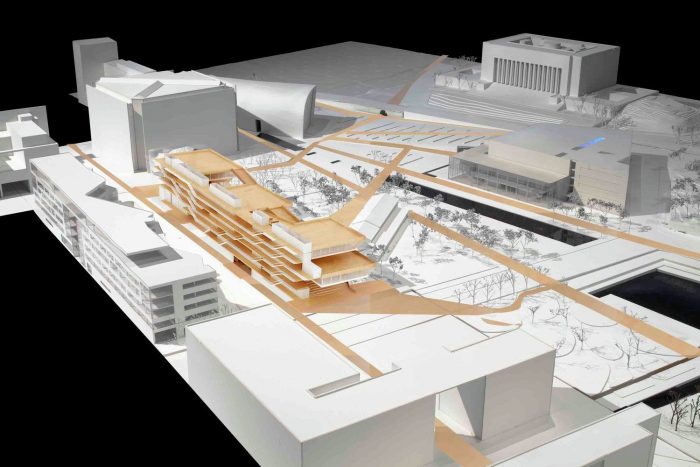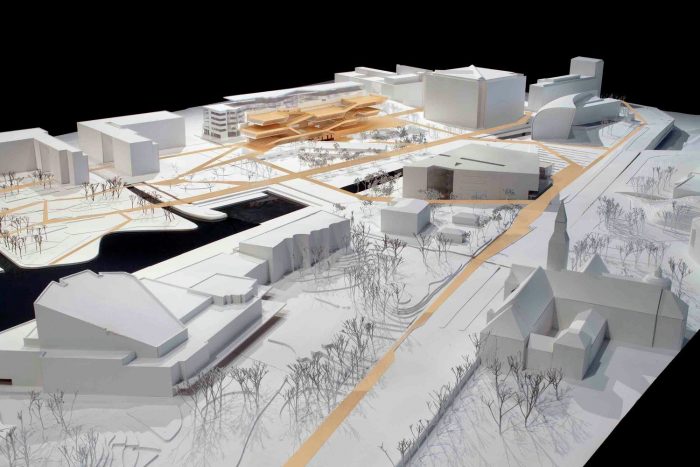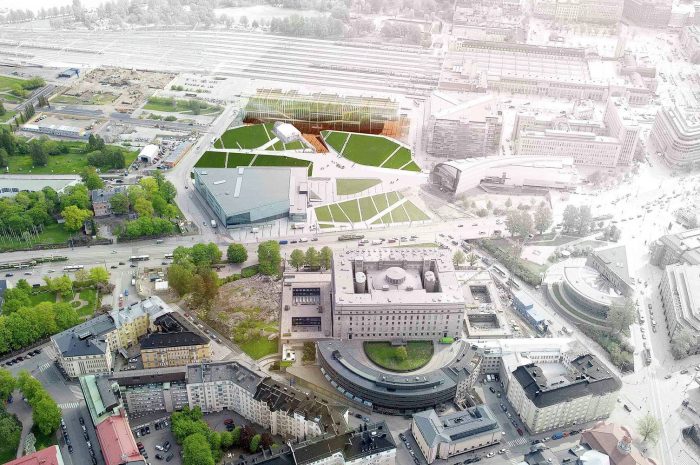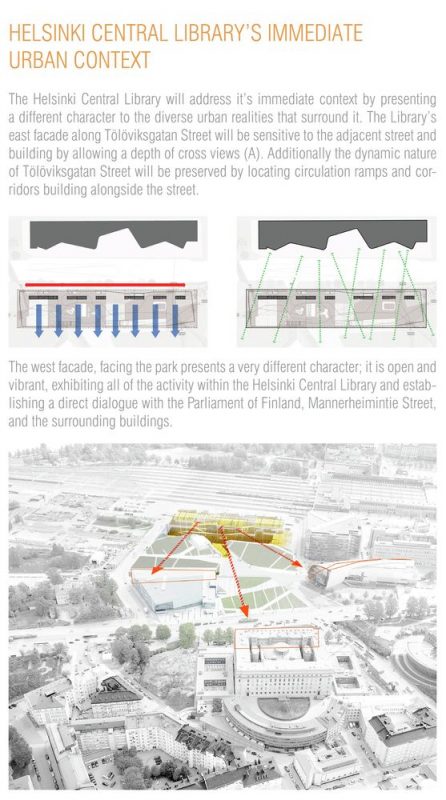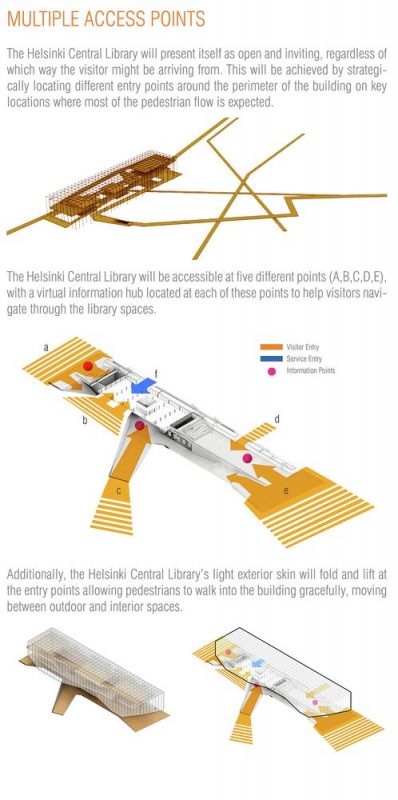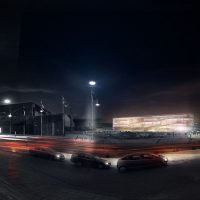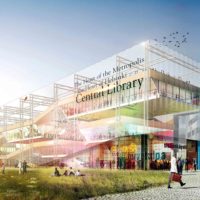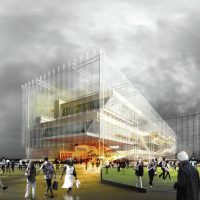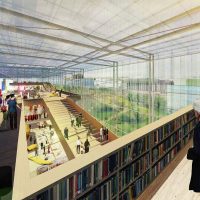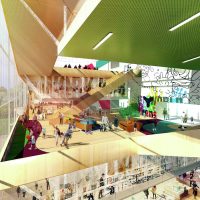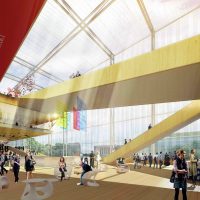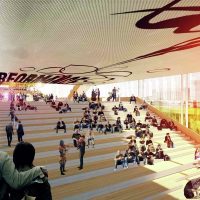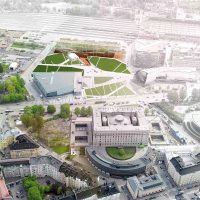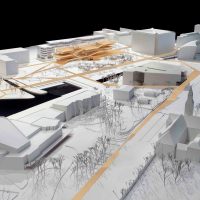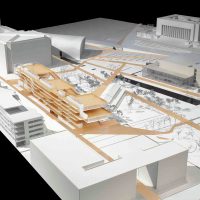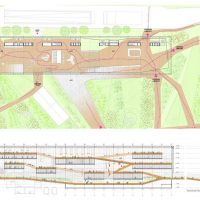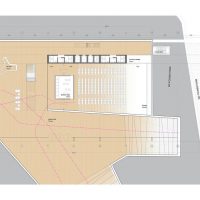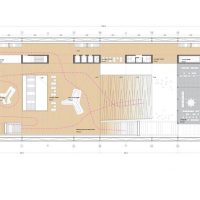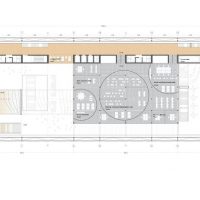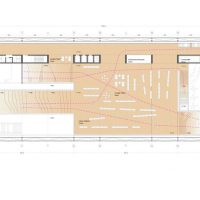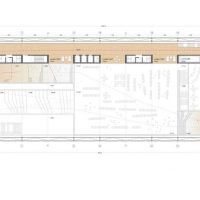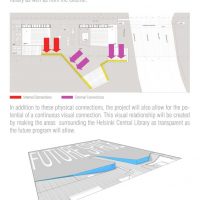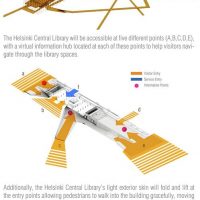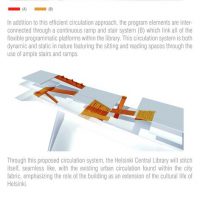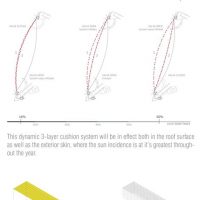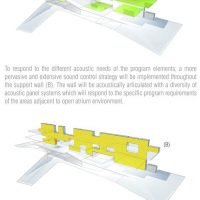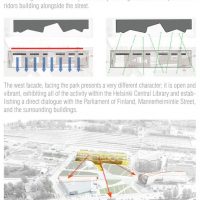PRAUD unveiled their entry of Helsinki Central Library Competition, titled ‘The Heart of the Metropolis’. The proposal aims at becoming a ‘Living Room’ for the city. The Living room, which sits in the atrium, serves for multiple uses, as an auditorium, hall space, social space, lounge, or large functions. This unique space will be singular not only for Helsinki, but as a new model for other future libraries. More details about the project comes from the architects after the jump.
Architecturally, we were thinking of how to maximize the relationship between the city, the library, and its surroundings with a clear massing strategy. Because the building is oriented North to South, a vertical doughnut is stretched along the North and South axis to create a large elevated atrium that serves as the city living room. This strategy allows for the library collection to be elevated as a beacon of education to the city while all other programming is organized around the atrium.

In order to create flexibility between the public educational program and the social living room, we encapsulate larger elements into structural tubes that sit within two mega-trusses. This allows for a duality of spatial relation where programs, like the cinema, can be inside one of the tubes while lounges connect to the atrium. The main goal for this building will be to provide the sense of urbanity, social interaction and mixing, views to the city, interaction between the neighboring cultural facilities, while encompassing a new vision for education in a single building.
Energy Supply Solution
The massing strategy allows for maximum use of roof surface for solar panels while maintaining minimum footprint for public use. The large roof area can be optimize for solar water heating. The building can also make use of geothermal energy for heating. One of the strength of the design is district heating/cooling solution. The strategy of housing larger programs into the structural tubes serves also for energy efficiency. Each of these tubes can be regulated separately, cooling or heating as necessary. As the tubes move higher along the truss, they will be equipped with a heat recovery system to maximize heating and cooling.
Heating
The maximum use of roof surface for solar panels will let the building have enough energy to heat waters in the library. More importantly though, we tried to use the nature of our design as part of energy efficient strategy. For instance, the vertical courtyard “living room” will function as a space to encapsulate the heat that is gained from the sun and can distribute it to other parts of building especially to the collection area on top of the living room.
Structures
Our focus in developing a strategy for sustainable architecture is focused on optimizing the structural elements so that the least amount of elements are used or wasted. The strategy here is simple, we use two structural truss tubes that are leaning while being held in tension. To counteract the lateral forces, structural tubes slide between the trusses. The tensile element becomes a spatial element that houses the library stacks. The tubes house enclosed programs like the cinema, sauna, childrens’ world, digital program, and others. All other areas become open and accessible for social mixing.
Windows and Lighting
The atrium “living room” is protected by a triple glazing glass facade system. This large opening is possible because of its north-south orientation, which allows for indirect natural lighting minimizing the use of artificial lights for the major space. Also, as most of programs in the tubes require less natural light for their functions, facade of tubes are composed with patterned frosted glass so that it can control day light coming in. Basically, other than rooms in the tubes, which requires less natural light, most parts of the building will have maximized natural light with generous surface area of windows. For instance, main lobby area will capture most of lights from the natural light that is coming through generous double-storey, some part triple, space.

Ventilation and Cooling
The main mechanical space is located on the second floor basement, and all ducts will run through four major shafts that are integrated with elevators and inclinators. Since they are running mostly vertically, instead of horizontally, the efficiency of ventilation will increase, and a distributing room will be located right below the “living room” so that it can control the environment of the living room. Similar to the heating strategy, district cooling system is used in major spaces, especially in tubes, to maximize the efficiency of the cooling system. Additionally, operable windows at the top of “living room” facade will generate a strong natural wind tunnel effect in summer so that the living room can avoid green house effect and get more breeze.
Domestic Hot Water
Basically, most of domestic hot water that is used in the building will be heated by the solar panels on the roof. The proposal provides the maximum surface area of the roof and will be sufficient for heating domestic hot water.

Program
There are four big program in the library; collections, event space, learning facilities and public space. In this proposal, these four spaces are forming a vertical courtyard, the “living room”. Hence, the living room becomes a major public space that links between all main program spaces. Also it functions as an urban space for all visitors of the complex. This building serves a larger role within this compound of civic public buildings that allows the visitors to observe the area from a different perspective. Programmatic elements that need to be enclosed are placed within structural tubes. This allows for specific acoustical, electrical, and temperature controls to occur for each element. A cinema could be showing a movie while people read undisturbed outside. Lounge areas happen as the negative space formed by the tubes. This allows for a greater distribution of alternative lounge spaces, and social spaces. The building provides versatility for its users.
The Living room, which sits in the atrium, serves for multiple uses, as an auditorium, hall space, social space, lounge, or large functions. This unique space will be singular not only for Helsinki, but as a new model for other future libraries.
- Courtesy of © PRAUD
- Courtesy of © PRAUD
- Courtesy of © PRAUD
- Courtesy of © PRAUD
- Courtesy of © PRAUD
- Courtesy of © PRAUD
- Courtesy of © PRAUD
- Courtesy of © PRAUD
- Courtesy of © PRAUD
- Courtesy of © PRAUD
- Render Site Plan
- Render Plan
- Render Plan
- Render Plan
- Render Plan
- Render Plan
- Render Plan
- Details
- Details
- Details
- Details
- Details
- Details
- Details


